Scientific name Cichlidae | Higher classification Labroidei | |
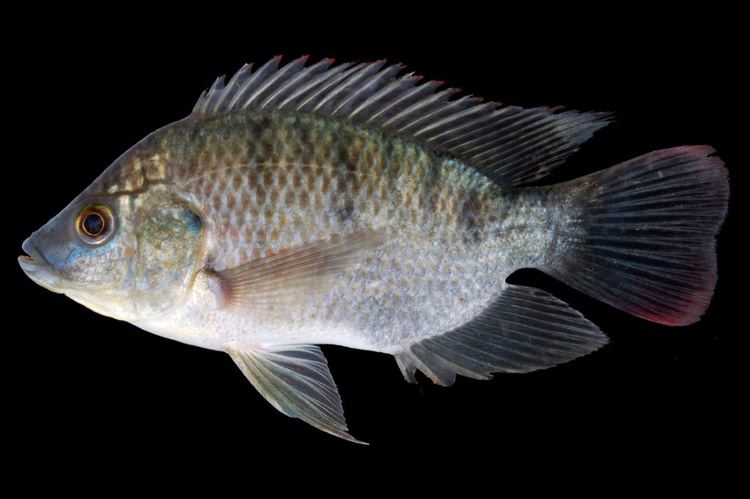 | ||
Family CichlidaeBonaparte, 1835 Mass Length Oscar: 36 cm, Mozambique Tilapia: 35 cm, Oreochromis aureus: 13 – 20 cm, Pterophyllum leopoldi: 5 cm Lower classifications Discus, Angelfishes, Oscar, Jack Dempsey, Humphead Cichlid | ||
Cichlids species sweet cichlid species show
Cichlids /ˈsɪklᵻdz/ are fish from the family Cichlidae in the order Perciformes. Cichlids are members of a suborder known as Labroidei, along with the wrasses (Labridae), damselfishes (Pomacentridae), and surfperches (Embiotocidae). This family is both large and diverse. At least 1,650 species have been scientifically described, making it one of the largest vertebrate families. New species are discovered annually, and many species remain undescribed. The actual number of species is therefore unknown, with estimates varying between 2,000 and 3,000. Cichlids are popular freshwater fish kept in the home aquarium.
Contents
- Cichlids species sweet cichlid species show
- African cichlid fish room tour african cichlid aquarium
- Description
- Anatomy and appearance
- Taxonomy
- Distribution and habitat
- Feeding
- Reproduction
- Brood care
- Open brooding
- Cave brooding
- Ovophile mouthbrooding
- Larvophile mouthbrooding
- Mating
- Speciation
- Population status
- Lake Victoria
- Food and game fish
- Tilapia
- Game fish
- Aquarium fish
- Hybrids and selective breeding
- Aquarium hybrids
- Genera
- References

African cichlid fish room tour african cichlid aquarium
Description

Cichlids span a wide range of body sizes, from species as small as 2.5 cm (0.98 in) in length (e.g., female Neolamprologus multifasciatus) to much larger species approaching 1 m (3.3 ft) in length (Boulengerochromis and Cichla). As a group, cichlids exhibit a similar diversity of body shapes, ranging from strongly laterally compressed species (such as Altolamprologus, Pterophyllum, and Symphysodon) to species that are cylindrical and highly elongated (such as Julidochromis, Teleogramma, Teleocichla, Crenicichla, and Gobiocichla). Generally, however, cichlids tend to be of medium size, ovate in shape, and slightly laterally compressed, and generally similar to the North American sunfishes in morphology, behavior, and ecology.
Many cichlids, particularly Tilapia, are important food fishes, while others are valued game fish (e.g. Cichla species). The family also includes many familiar aquarium fish, including the angelfish, oscars, and discus. Cichlids have the largest number of endangered species among vertebrate families, most in the haplochromine group. Cichlids are particularly well known for having evolved rapidly into a large number of closely related but morphologically diverse species within large lakes, particularly Tanganyika, Victoria, Malawi, and Edward. Their diversity in the African Great Lakes is important for the study of speciation in evolution. Many cichlids introduced into waters outside of their natural range have become nuisances.
Anatomy and appearance
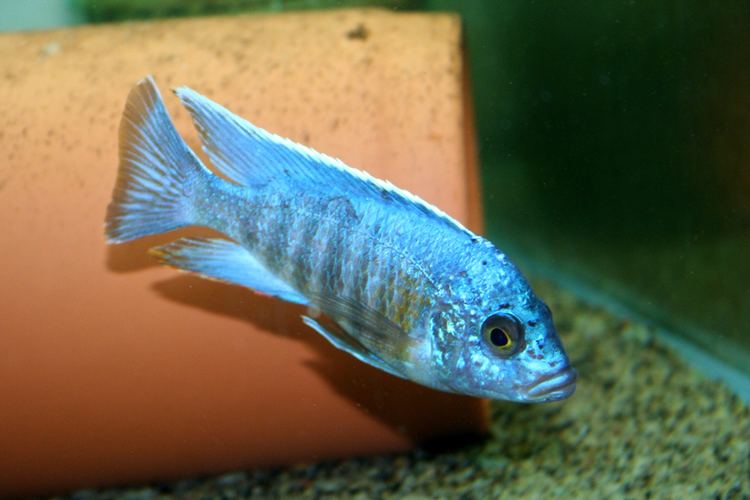
Cichlids share a single key trait: the fusion of the lower pharyngeal bones into a single tooth-bearing structure. A complex set of muscles allows the upper and lower pharyngeal bones to be used as a second set of jaws for processing food, allowing a division of labor between the "true jaws" (mandibles) and the "pharyngeal jaws". Cichlids are efficient and often highly specialized feeders that capture and process a very wide variety of food items. This is assumed to be one reason why they are so diverse. Cichlids vary in body shape, ranging from compressed and disc-shaped (such as Symphysodon and Heros), to triangular (such as Pterophyllum and Uaru) to elongated and cylindrical (such as Crenicichla and Biotoecus).
The features that distinguish them from the other families in Labroidei include:
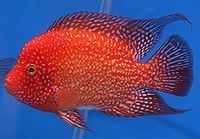
Taxonomy
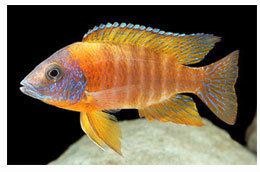
Kullander (1998) recognizes eight subfamilies of cichlids: the Astronotinae, Cichlasomatinae, Cichlinae, Etroplinae, Geophaginae, Heterochromidinae, Pseudocrenilabrinae, and Retroculinae. A ninth subfamily, Ptychochrominae, was later recognized by Sparks and Smith. Cichlid taxonomy is still debated, and classification of genera cannot yet be definitively given. A comprehensive system of assigning species to monophyletic genera is still lacking, and there is not complete agreement on what genera should be recognized in this family.
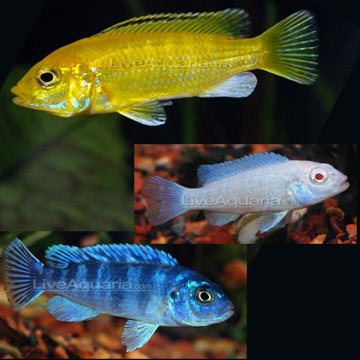
As an example of the classification problems, Kullander placed the African genus Heterochromis phylogenetically within Neotropical cichlids, although later papers concluded otherwise. Other problems center upon the identity of the putative common ancestor for the Lake Victoria superflock, and the ancestral lineages of Tanganyikan cichlids.

Comparisons between a morphologically-based phylogeny and analyses of gene loci produce differences at the genus level. There remains a consensus that the Cichlidae as a family is monophyletic.

In cichlid taxonomy, dentition was formerly used as a classifying characteristic. However, this was complicated by the fact that in many cichlids, tooth shape changes with age, due to wear, and cannot be relied upon. Genome sequencing and other technologies transformed cichlid taxonomy.
Distribution and habitat

Cichlids are one of the largest vertebrate families in the world. They are most diverse in Africa and South America. Africa alone is estimated to host at least 1,600 species. Central America and Mexico have about 120 species, as far north as the Rio Grande in southern Texas. Madagascar has its own distinctive species (Katria, Oxylapia, Paratilapia, Paretroplus, Ptychochromis, and Ptychochromoides), only distantly related to those on the African mainland. Native cichlids are largely absent in Asia, except for 9 species in Israel, Lebanon, and Syria (Astatotilapia flaviijosephi, Oreochromis aureus, O. niloticus, Sarotherodon galilaeus, Coptodon zillii, and Tristramella spp.), two in Iran (Iranocichla), and three in India and Sri Lanka (Etroplus and Pseudetroplus). If disregarding Trinidad and Tobago (where the few native cichlids are members of genera that are widespread in the South American mainland), the three species from the genus Nandopsis are the only cichlids from the Antilles in the Caribbean, specifically Cuba and Hispaniola. Europe, Australia, Antarctica, and North America north of the Rio Grande drainage have no native cichlids, although in Florida, Mexico, Japan and northern Australia, feral populations of cichlids have become established as exotics.
Although most cichlids are found at relatively shallow depths, several exceptions do exist. These include species such as Alticorpus macrocleithrum and Pallidochromis tokolosh down to 150 m (490 ft) below the surface in Lake Malawi, and the whitish (nonpigmented) and blind Lamprologus lethops, which is believed to live as deep as 160 m (520 ft) below the surface in the Congo River.
Cichlids are less commonly found in brackish and saltwater habitats, though many species tolerate brackish water for extended periods; Cichlasoma urophthalmus, for example, is equally at home in freshwater marshes and mangrove swamps, and lives and breeds in saltwater environments such as the mangrove belts around barrier islands. Several species of Tilapia, Sarotherodon, and Oreochromis are euryhaline and can disperse along brackish coastlines between rivers. Only a few cichlids, however, inhabit primarily brackish or salt water, most notably Etroplus maculatus, Etroplus suratensis, and Sarotherodon melanotheron. The perhaps most extreme habitats for cichlids are the warm hypersaline lakes where the members of the genera Alcolapia and Danakilia are found. Lake Abaeded in Eritrea encompasses the entire distribution of D. dinicolai, and its temperature ranges from 29 to 45 °C (84 to 113 °F).
With the exception of the species from Cuba, Hispaniola, and Madagascar, cichlids have not reached any oceanic island and have a predominantly Gondwanan distribution, showing the precise sister relationships predicted by vicariance: Africa-South America and India-Madagascar. The dispersal hypothesis, in contrast, requires cichlids to have negotiated thousands of kilometers of open ocean between India and Madagascar without colonizing any other island or, for that matter, crossing the Mozambique Channel to Africa. Although the vast majority of Malagasy cichlids are entirely restricted to fresh water, Ptychochromis grandidieri and Paretroplus polyactis are commonly found in coastal brackish water and they are apparently salt tolerant, as is also the case for Etroplus maculatus and E. suratensis from India and Sri Lanka.
Feeding
Many cichlids are primarily herbivores, feeding on algae (e.g. Petrochromis) and plants (e.g. Etroplus suratensis). Small animals, particularly invertebrates, are only a minor part of their diets.
Other cichlids are detritivores and eat organic material, called Aufwuchs; among these species are the tilapiines of the genera Oreochromis, Sarotherodon, and Tilapia.
Other cichlids are predatory and eat little or no plant matter. These include generalists that catch a variety of small animals, including other fishes and insect larvae (e.g. Pterophyllum), as well as variety of specialists. Trematocranus is a specialized snail-eater, while Pungu maclareni feeds on sponges. A number of cichlids feed on other fish, either entirely or in part. Crenicichla species are stealth-predators that lunge from concealment at passing small fish, while Rhamphochromis species are open-water pursuit predators that chase down their prey. Paedophagous cichlids such as the Caprichromis species eat other species' eggs or young, in some cases ramming the heads of mouthbrooding species to force them to disgorge their young. Among the more unusual feeding strategies are those of Corematodus, Docimodus evelynae, Plecodus, Perissodus, and Genyochromis spp., which feed on scales and fins of other fishes, a behavior known as lepidophagy, along with the death-mimicking behaviour of Nimbochromis and Parachromis species, which lay motionless, luring small fish to their side prior to ambush.
This variety of feeding styles has helped cichlids to inhabit similarly varied habitats. Its pharyngeal teeth (teeth in the throat) afford cichlids so many "niche" feeding strategies, because the jaws pick and hold food, while the pharyngeal teeth crush the prey.
Reproduction
Cichlids have highly organized breeding activities.
Brood care
All species show some form of parental care for both eggs and larvae, often nurturing free-swimming young until they are weeks or months old.
Communal parental care, where multiple monogamous pairs care for a mixed school of young have also been observed in multiple cichlid species, including Amphilophus citrinellus, Etroplus suratensis, and Tilapia rendalli. Comparably, the fry of Neolamprologus brichardi, a species that commonly lives in large groups, are protected not only by the adults, but also by older juveniles from previous spawns. Several cichlids, including discus (Symphysodon spp.), some Amphilophus species, Etroplus, and Uaru species, feed their young with a skin secretion from mucous glands.
The species Neolamprologus pulcher uses a cooperative breeding system, in which one breeding pair has many helpers which are subordinate to the dominant breeders.
Parental care falls into one of four categories: substrate or open brooders, secretive cave brooders (also known as guarding speleophils), and at least two types of mouthbrooders, ovophile mouthbrooders and larvophile mouthbrooders.
Open brooding
Open- or substrate-brooding cichlids lay their eggs in the open, on rocks, leaves, or logs. Examples of open-brooding cichlids include Pterophyllum and Symphysodon species and Anomalochromis thomasi. Male and female parents usually engage in differing brooding roles. Most commonly, the male patrols the pair's territory and repels intruders, while the female fans water over the eggs, removing the infertile and leading the fry while foraging. However, both sexes are able to perform the full range of parenting behaviours.
Cave brooding
Secretive cave-spawning cichlids lay their eggs in caves, crevices, holes, or discarded mollusc shells, frequently attaching the eggs to the roof of the chamber. Examples include Pelvicachromis spp., Archocentrus spp., and Apistogramma spp. Free-swimming fry and parents communicate in captivity and in the wild. Frequently, this communication is based on body movements, such as shaking and pelvic fin flicking. In addition, open- and cave-brooding parents assist in finding food resources for their fry. Multiple neotropical cichlid species perform leaf-turning and fin-digging behaviors.
Ovophile mouthbrooding
Ovophile mouthbrooders incubate their eggs in their mouths as soon as they are laid, and frequently mouthbrood free-swimming fry for several weeks. Examples include many East African Rift lakes (Lake Malawi, Lake Tanganyika and Lake Victoria) endemics, e.g.: Maylandia, Pseudotropheus, Tropheus, and Astatotilapia burtoni, along with some South American cichlids such as Geophagus steindachneri.
Larvophile mouthbrooding
Larvophile mouthbrooders lay eggs in the open or in a cave and take the hatched larvae into the mouth. Examples include some variants of Geophagus altifrons, and some Aequidens, Gymnogeophagus, and Satanoperca, as well as Oreochromis mossambicus and Oreochromis niloticus. Mouthbrooders, whether of eggs or larvae, are predominantly females. Exceptions that also involve the males include eretmodine cichlids (genera Spathodus, Eretmodus, and Tanganicodus), some Sarotherodon species, Chromidotilapia guentheri, and some Aequidens species. Rare paternal mouthbrooding occurs, for example, in Sarotherodon melanotheron. This method appears to have evolved independently in several groups of African cichlids.
Mating
Cichlids mate either monogamously or polygamously. The mating system of a given cichlid species is not consistently associated with its brooding system. For example, although most monogamous cichlids are not mouthbrooders, Chromidotilapia, Gymnogeophagus, Spathodus and Tanganicodus all include - or consist entirely of - monogamous mouthbrooders. In contrast, numerous open- or cave-spawning cichlids are polygamous; examples include many Apistogramma, Lamprologus, Nannacara, and Pelvicachromis species.
Speciation
Cichlids provide scientists with a unique perspective of speciation, having become extremely diverse in the more recent geological past. It is widely believed that one of the contributing factors to their diversification are the various forms of prey processing displayed by cichlid pharyngeal jaw apparatus. These different jaw apparatus allow for a broad range of feeding strategies including: algae scraping, snail crushing, planktivores, piscivores, and insectivores. Some cichlids can also show phenotypic plasticity in their pharyngeal jaws, which can also help lead to speciation. In response to different diets or food scarcity, members of the same species can display different jaw morphologies that are better suited to different feeding strategies. As species members begin to concentrate around different food sources and continue their life cycle, they most likely spawn with like individuals. This can reinforce the jaw morphology and given enough time, create new species. Such a process can happen through allopatric speciation, when species diverge according to different food sources in different areas, or through sympatric speciation, in which multiple species evolve from a shared ancestor. In Lake Apoyo in Nicaragua, Amphilophus zaliosus and its sister species Amphilophus citrinellus display many of the criteria needed for sympatric speciation. In the African rift lake system, cichlid species in numerous distinct lakes evolved from a shared hybrid swarm.
Population status
In 2010, the International Union for Conservation of Nature classified 184 species as vulnerable, 52 as endangered, and 106 as critically endangered. At present, the IUCN only lists Yssichromis sp. nov. "argens" as extinct in the wild, and six species are listed as entirely extinct, but it is acknowledged that many more possibly belong in these categories (for example, Haplochromis aelocephalus, H. apogonoides, H. dentex, H. dichrourus and numerous other members of the genus Haplochromis have not been seen since the 1980s, but are maintained as Critically Endangered in the small chance that tiny –but currently unknown– populations survive).
Lake Victoria
Because of the introduced Nile perch (Lates niloticus) and water hyacinth, deforestation that led to water siltation, and overfishing, many Lake Victoria species have been wiped out or drastically reduced. By around 1980, lake fisheries yielded only 1% cichlids, a drastic decline from 80% in earlier years.
About two-thirds of endemic cichlids (about 300 species), especially bottom feeders, became endangered or extinct. Some survivors have adapted by becoming smaller or hybridizing with other species. Satellite lakes, such as Lake Edward and Lake Kyoga, have not been as strongly affected, however, and harbor an array of similar species.
Food and game fish
Although cichlids are mostly small- to medium-sized, many are notable as food and game fishes. With few thick rib bones and tasty flesh, artisan fishing is not uncommon in Central America and South America, as well as areas surrounding the African rift lakes.
Tilapia
The most important food cichlids, however, are the tilapiines of North Africa. Fast growing, tolerant of stocking density, and adaptable, tilapiine species have been introduced and farmed extensively in many parts of Asia and are increasingly common aquaculture targets elsewhere.
Farmed tilapia production is about 1,500,000 t (1,500,000 long tons; 1,700,000 short tons) annually, with an estimated value of US$1.8 billion, about equal to that of salmon and trout.
Unlike those carnivorous fish, tilapia can feed on algae or any plant-based food. This reduces the cost of tilapia farming, reduces fishing pressure on prey species, avoids concentrating toxins that accumulate at higher levels of the food chain, and makes tilapia the preferred "aquatic chickens" of the trade.
Game fish
Many large cichlids are popular game fish. The peacock bass (Cichla species) of South America is one of the most popular sportfish. It was introduced in many waters around the world. In Florida, this fish generates millions of hours of fishing and sportfishing revenue of more than US$8 million a year. Other cichlids preferred by anglers include the oscar, Mayan cichlid (Cichlasoma urophthalmus), and jaguar guapote (Parachromis managuensis).
Aquarium fish
Since 1945, cichlids have become increasingly popular as aquarium fish.
The most common species in hobbyist aquaria is Pterophyllum scalare from the Amazon River basin in tropical South America, known in the trade as the "angelfish". Other popular or readily available species include the oscar (Astronotus ocellatus), convict cichlid (Archocentrus nigrofasciatus) and discus fish (Symphysodon).
Hybrids and selective breeding
Some cichlids readily hybridize with related species, both in the wild and under artificial conditions. Other groups of fishes, such as European cyprinids, also hybridize. Unusually, cichlid hybrids have been put to extensive commercial use, in particular for aquaculture and aquaria. The hybrid red strain of tilapia, for example, is often preferred in aquaculture for its rapid growth. Tilapia hybridization can produce all-male populations to control stock density or prevent reproduction in ponds.
Aquarium hybrids
The most common aquarium hybrid is perhaps the blood parrot cichlid, which is a cross of several species, especially from species in the genus Amphilophus. (There are many hypotheses, but the most likely is: [ Amphilophus labiatus x ([Vieja Synspillus] x [Heros Severus])) With a Triangular-shaped mouth, an abnormal spine, and an occasionally missing caudal fin (known as the "love heart" parrot cichlid), the fish is controversial among aquarists. Some have called blood parrot cichlids "the Frankenstein monster of the fish world". Another notable hybrid, the flowerhorn cichlid, was very popular in some parts of Asia from 2001 until late 2003, and is believed to bring good luck to its owner. The popularity of the flowerhorn cichlid declined in 2004. Owners released many specimens into the rivers and canals of Malaysia and Singapore, where they threaten endemic communities.
Numerous cichlid species have been selectively bred to develop ornamental aquarium strains. The most intensive programs have involved angelfish and discus, and many mutations that affect both coloration and fins are known. Other cichlids have been bred for albino, leucistic, and xanthistic pigment mutations, including oscars, convict cichlid and Pelvicachromis pulcher. Both dominant and recessive pigment mutations have been observed. In convict cichlids, for example, a leucistic coloration is recessively inherited, while in Oreochromis niloticus niloticus, red coloration is caused by a dominant inherited mutation.
This selective breeding may have unintended consequences. For example, hybrid strains of Mikrogeophagus ramirezi have health and fertility problems. Similarly, intentional inbreeding can cause physical abnormalities, such as the notched phenotype in angelfish.
Genera
The genus list is as per FishBase. Studies are continuing, however, on the members of this family, particularly the haplochromine cichlids of the African rift lakes.
